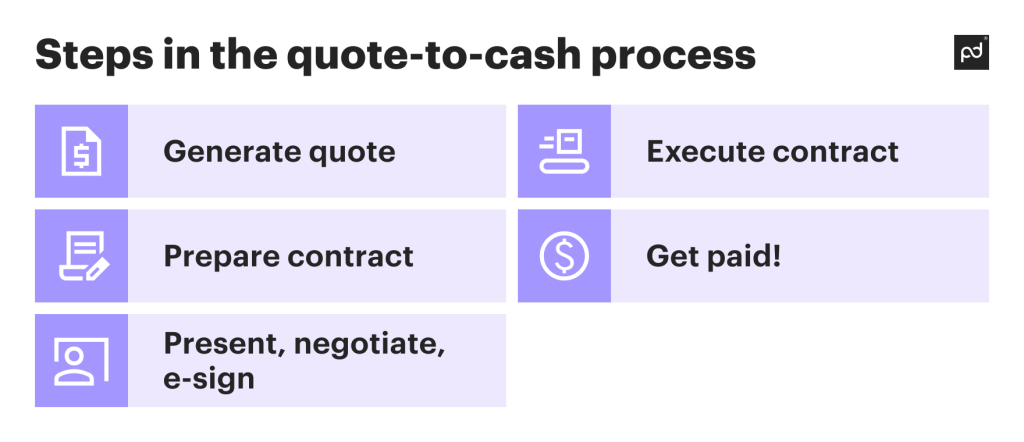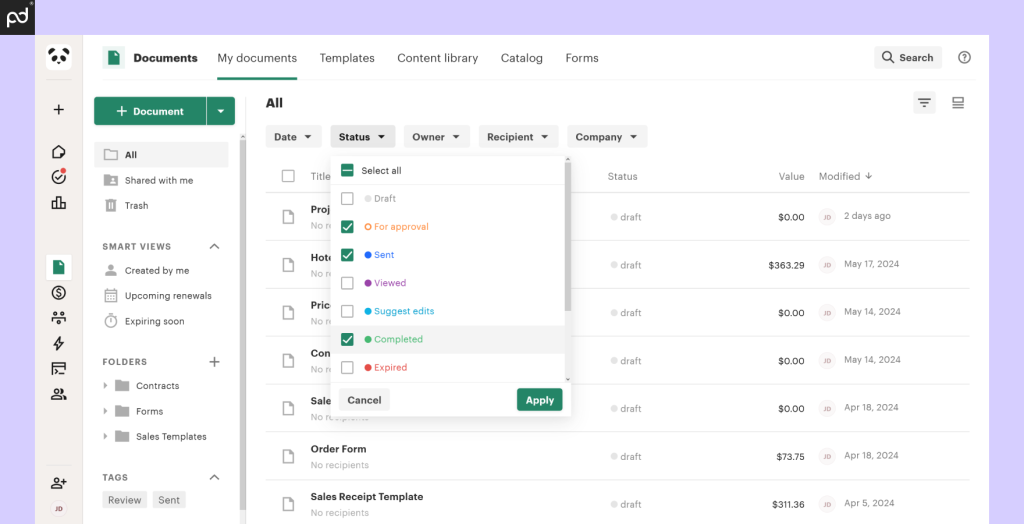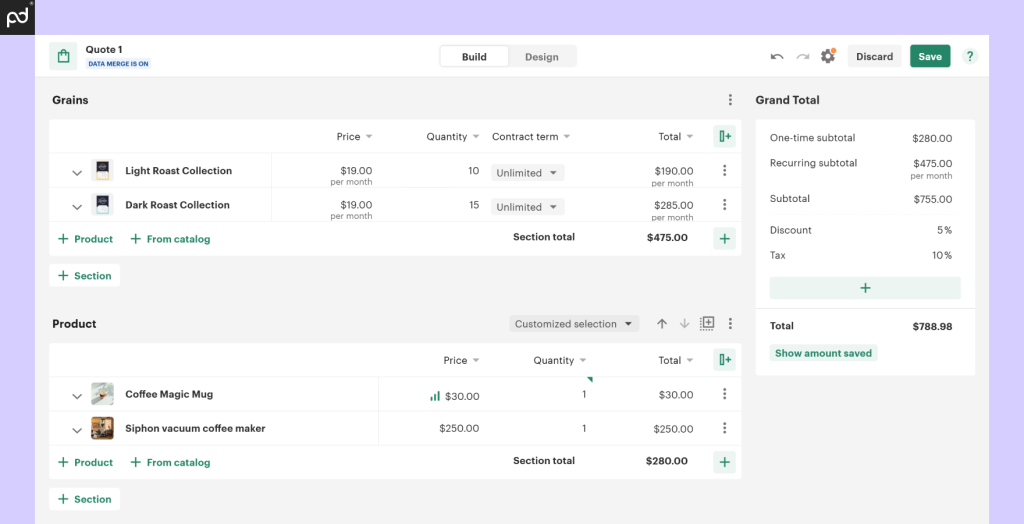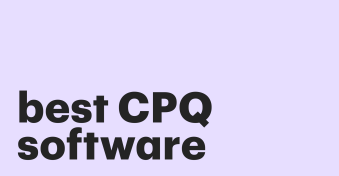From first contact to final sale, understanding and properly applying the Q2C process streamlines operations, eradicates inefficiencies, and drives profits.
This article explores the significance of quote-to-cash for accelerating sales operations and achieving long-term business goals.
Key takeaways
- Quote-to-cash spans the entire duration of the sales process
- A seamless quote-to-cash cycle minimizes errors, reduces delays, and improves customer experience.
- One of the most important aspects of the quote-to-cash process lies in its ability to align sales, finance, and fulfillment departments.
- Thoughtful implementation and continuous improvement of the quote-to-cash process is pivotal for sustained success and securing a competitive edge in the market.
What does quote-to-cash mean?
In business process automation, the quote-to-cash (a.k.a QTC or Q2C) process stands as an essential element for generating revenue.
The name of the process is fairly self-explanatory.
Metaphorically speaking, it’s a bridge between clients expressing interest in a product or service and the moments when the deal is formally sealed and payment is received.
Q2C kicks off right after a lead has been qualified as an opportunity and the client has explicitly requested a cost estimate.
In a nutshell, Q2C is all about efficiently translating customer interest into tangible financial gains, and doing so while ensuring a smooth and transparent experience for all parties involved.
With modern document automation capabilities, businesses can drastically reduce manual errors and administrative overhead, empowering teams to focus their efforts and time on value-added tasks rather than mundane paperwork.
Furthermore, robust proposal management features enable organizations to craft compelling proposals tailored to each client’s unique needs, thereby increasing the likelihood of winning their business and accelerating the quote-to-cash cycle.
What role does CPQ (configure, price, quote) play in Q2C?
Although these abbreviations look somewhat similar and are often used in the same context, there is a distinct difference between the two.
Configure, price, quote, or CPQ, is a subprocess of the overall Q2C framework that deals exclusively with quote creation.
It is especially important for companies that work with complex products or services, where the sheer number of components and pricing variations can be overwhelming or where the inclusion of a certain component in a product configuration can render some of the previously made selections irrelevant.
Therefore, CPQ is placed early on the QTC process timeline and deals with the task of quickly putting together accurate, non-conflicting, highly detailed sales quotes with the most up-to-date prices and component descriptions pulled from verified sources such as a corporate ERP (enterprise resource management) or PIM (product information management) system.
Who owns the quote-to-cash process?
Unlike CPQ software and corresponding business processes that are specifically owned by salespeople relying on pre-configured and pre-approved configurations and prices, the overarching Q2C process is a joint responsibility of various teams and departments, including legal, sales, finance, manufacturing, and potentially others.
This happens because Q2C typically requires input from a variety of people within a company who provide feedback, suggestions, and approvals at different stages — from contract drafting to resolving issues during contract negotiations and arranging payments.
Steps in the quote-to-cash process
Although the exact number of process steps can vary from company to company, the standard process usually goes as follows:

Quote generation and presentation
Salespeople produce service estimates or generate product quotes to present to the client.
Alternatively, they can skip the quote part and cut straight to the formal proposal stage with detailed information on the service/product to be sold to the client.
At this point, an outgoing document may require approvals from relevant departments or stakeholders in the company.
Contract preparation
If the proposal is accepted by the client, the team starts working on the contract, which may involve representatives of several departments, including Finance, Legal, and those directly responsible for the products or services in question.
This can be done traditionally, by passing the document to different departments in a sequence and repeating the cycle until the document is finalized.
However, it’s far more effective to use modern collaborative tools or even deal rooms for faster redlining and contract finalization.
Contract presentation, negotiation, and signing
Once the finalized draft of the proposal is presented to the client, it marks the beginning of the contract negotiation phase.
Task completion here may also involve several groups of people on either side — and where traditional methods of redlining and editing gain maximum potential for delays, miscommunications, and good old human errors.
The use of modern contract management solutions with advanced collaboration features can turn this process into a more manageable, streamlined experience for all parties involved.
When everyone is on the same page, the contract is signed by corresponding executives on each side — most probably, using an electronic signature.
Contact fulfillment
At this stage, the contract is executed and corresponding products are shipped to the client or their production starts.
In service agreements, the service starts on the effective date specified in the contract.
Invoicing
Invoices can be sent immediately upon signing the contract (in the case of product sales or service prepayments), or upon delivery or reaching an agreed-upon invoicing period (in service agreements).
However, this is not the end of the Q2C process, as we are only looking at accrued revenue now.
Revenue recognition
When the payment successfully lands in the seller’s or vendor’s bank account, the Q2C process is complete.
Some organizations also include contract renewal in their Q2C framework, as it essentially restarts the revenue generation cycle.
How to improve the quote-to-cash process
Now that we are clear on general definitions, let’s take a look at the most efficient ways of boosting the performance of this process framework for the benefit of your company, employees, and, of course, clients.
Use workflow automation software to save time
Accelerating the quote-to-cash process is absolutely vital for businesses seeking to optimize their sales pipeline and drive revenue growth.
One key strategy here involves leveraging document and proposal management software with workflow automation features.
By adopting such technology, businesses can streamline the entire quote-to-cash journey, from initial inquiry to order fulfillment and final payment collection.
These software solutions empower teams to generate professional-looking quotes quickly, with accurate pricing and terms tailored to each client’s needs.
Efficiency is further enhanced by automating repetitive tasks, thus reducing the chance of manual errors and expediting the multi-step approval process.
Bridge data gaps and centralize storage
Another useful method of enhancing the quote-to-cash process is by centralizing data previously stored in silos and unifying communication channels.
Document and proposal management software facilitates collaboration among sales reps, finance teams, and clients by providing a centralized platform for storing and accessing crucial information.
A cloud-native, highly secure, and scalable SaaS platform that is compliant with all major security standards and regulations will guarantee the integrity of your most valuable documents at all times.
With real-time visibility into the status of quotes, proposals, contracts, and invoices, teams can collaborate more effectively, foresee potential roadblocks, anticipate requests, and proactively address the needs of their customers.
Moreover, centralized data storage (either on the platform’s own servers or in an integrated cloud storage of your choice) offers an extra layer of information security and enables businesses to track key performance metrics, identify process bottlenecks, and continuously optimize their sales team’s workflows for maximum efficiency.

Leverage cross-functional integrations to the fullest
Integrating proposal and document management software with existing CRM (customer relationship management) and ERP (enterprise resource planning) systems can further streamline and accelerate the quote-to-cash process.
By synchronizing customer data between platforms, businesses can ensure consistency across sales, marketing, and finance departments.
This integration enables a seamless transition from lead generation to quote generation, improving response times and enhancing the customer experience.
Additionally, automated data syncing reduces the risk of data discrepancies and ensures accurate reporting and forecasting.
All things considered, investing in document and proposal management software with workflow automation capabilities and integrating it with CRM systems is the fastest lane toward a better-performing, more efficient business organization.
Put pre-made and custom document templates to good use
Reusability is a fundamental concept in automation because it allows for increased efficiency and scalability.
In practical terms, it means that templates are the key to faster processes, fewer delays, and more deals closed by your salespeople.
Let’s refer to the PandaDoc platform again to demonstrate. It comes loaded with hundreds of pre-made templates for any occasion and document type.
You can use them “as is” or modify them to your liking.
The powerful built-in editor gives you complete freedom in terms of modifying every aspect of your document, adding media files, dynamic pricing tables, and more.
Furthermore, the solution also boasts CPQ functionality through its easy-to-use product catalog and seamless integrations with a variety of popular business tools, including mainstream CRMs like Salesforce, HubSpot, and MS Dynamics.

Solve your quote-to-cash needs with PandaDoc
Navigating the complexities of modern sales environments requires a strategic quote-to-cash process to always stay on top of sales operations.
PandaDoc can help create this framework.
Alongside the tools mentioned above, like advanced quoting software and template libraries, features such as version history and status tracking make it easy for your team to instantly revert to previous versions or identify changes made by other collaborators.
And once you resolve final edits and all parties are ready to sign, secure eSignatures seal any deal in minutes without leaving the same environment.
Curious to see how PandaDoc can level up your sales ops success?
We totally understand! Book a quick 15-minute demo to learn firsthand how the platform can accelerate your Q2C process.
Originally published June 26, 2017, updated August 19, 2024


